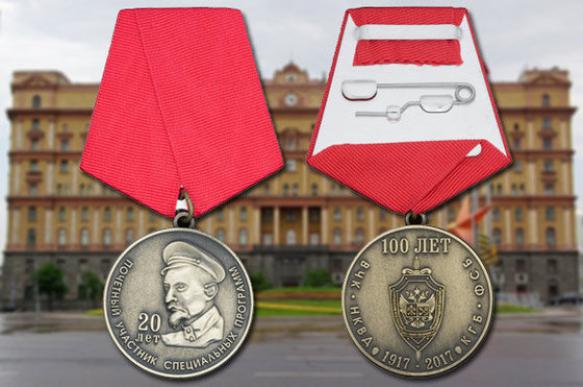Russia brings Felix Dzerzhinsky back on KGB medals
Goznak of Russia (State Administration for the Issue of Banknotes) has published information about a new medal "Honorary member of special programs." The appearance of the new medal has excited the Russian liberal opposition and, predictably, Ukrainian Internet activists and journalists. According to them, the new medal marks Russia's desire to go back to 1937, because the face of the medal will depict the founder of the All-Russian Commission for Combating Counterrevolution (Cheka), Felix Dzerzhinsky.

Many social networkers note that there are medals in foreign countries with images of Roosevelt and Jackson, Churchill, Charles de Gaulle and many other political figures, who were responsible for many more victims than Dzerzhinsky was.
The medal "Honorary member of special programs" was established for the Office of the Russian Federal Security Bureau in St. Petersburg and the Leningrad region. The medal is dedicated to the centennial of "Cheka-NKVD-KGB-FSB" and captures the continuity of Russian secret services from Soviet counterintelligence structures.
The face of the medal depicts the founder of the Cheka, Felix Dzerzhinsky. It has not been specified what kind of special programs the title of the medal stands for. The All-Russian Commission for Combating Counterrevolution (Cheka), which became the progenitor of Soviet and now Russian secret services, was established on December 7 (20) in 1917. Thus, the Russian counter-intelligence celebrates its anniversary.
The appearance of Dzerzhinsky's image on the medal has generated many discussions in Russia and former soviet states. Dzerzhinsky is traditionally associated with repression during Joseph Stalin's rule. However, Commissar Dzerzhinsky was also known for his efforts to support street children and for the fact that he was able to create a powerful and professional security service system in the new Soviet state practically from scratch.
Generally speaking, placing images of prominent historical figures on medals and banknotes is a common practice. For example, the most infamous incident associated with this trend is, perhaps, the appearance of the image of the 7th President Andrew Jackson on coins in the USA. Jackson directly initiated and approved the genocide of American Indians that went down in history as the "Trail of Tears." In 1830, Jackson signed the Indian Removal act.
In Europe, there are medals with images of Winston Churchill, who initiated a great deal of discriminatory political processes, for instance in India. There are medals with images of Charles de Gaulle and Roosevelt.
However, no one protests against the presence of images of those historical figures on state medals, commemorative signs and coins. In this respect, Russia follows a global trend, let alone the fact that Russian security services play a huge role in ensuring national security of the country.
Therefore, the knowledge of historical continuity, which Russian counter-intelligence services thus manifest, is just a tribute and respect to their roots and traditions.
"In fact, there is no politics or creeping Stalinization involved here. There is a simple story behind this. In St.Petersburg, there is a museum of the office of Felix Dzerzhinsky, on Gorokhovaya Street, in the first building of Cheka. The service used to take the entire building, whereas presently, there is only one Cheka office left there, and the rest of the building belongs to a variety of NGOs. Many wanted the building to be transformed into a museum of the KGB to mark the 100th anniversary of Cheka. However, the request was rejected," a high-ranking source at Russian special services told Pravda.Ru.
"They eventually decided to release a medal with Dzerzhinsky for officers of the agency. Afterwards, the initiative reached the federal level. Dzerzhinsky was not a bad special officer, and many other countries have medals, on which odious figures are displayed. Yet, the image of Felix Dzerzhinsky is seen in Russia as a symbol of the struggle against Soviet power. Many still remember the demolition of the monument to Dzerzhinsky, when the monument was hanging symbolically from a crane," the expert said.
"In 2017, Russia will mark 100 years since the establishment of the security service. Cheka and KGB evolved in the Federal Security Bureau, and no one denies succession at this point," director of the international Institute for New States, Alexei Martynov told politonline.ru. "The name and the image of Felix Dzerzhinsky was stained a lot during the 1990s. However, he was known for taking care of orphans and building railways too. I am convinced that most people will not mind his face on the medal," the expert added.
Pravda.Ru
Read article on the Russian version of Pravda.Ru
Subscribe to Pravda.Ru Telegram channel, Facebook, RSS!


